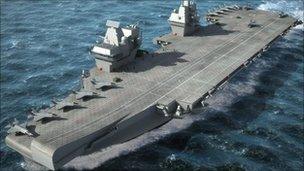Work begins on HMS Prince of Wales aircraft carrier
- Published
Defence Secretary Liam Fox cut the first steel for the aircraft carrier, the Prince of Wales, at the Govan shipyard
The first piece of steel has been cut on aircraft carrier HMS Prince of Wales at an official ceremony on the Clyde.
Defence Secretary Liam Fox started the computer-guided laser cutting tool at BAE Systems' shipyard in Govan.
The new Royal Navy aircraft carrier and its sister ship HMS Queen Elizabeth, which has been in construction since 2009, are expected to cost £5bn.
The carriers are due to launch in 2016 and 2018, and may not be ready for action until much later.
With the Ark Royal's fleet of Harrier jump jets being decommissioned, the Navy will be without carrier-based planes for almost a decade.

Artist's impression of one of the Royal Navy's super aircraft carriers
The two Queen Elizabeth (QE) class aircraft carriers, which escaped being cut in the government's defence review, are being built by Aircraft Carrier Alliance (ACA) consortium.
Dr Fox said: "We are committed to delivering this next generation of powerful British aircraft carriers that will mark a step change in our carrier strike capability and form the cornerstone of the Royal Navy's Future Force 2020.
"This major construction project is creating and sustaining thousands of jobs in shipyards around the country."
Second Sea Lord, Vice-Admiral Charles Montgomery, added: "The Queen Elizabeth Class will provide Britain with the means to deliver air power from the sea, wherever and whenever required, and in a stronger and more decisive form than ever before."
Members of the consortium, including BAE Systems, Babcock, Thales and the Ministry of Defence, also attended the event.
The pieces are being built at six shipyards around the UK and will be put together at Rosyth in Fife.
- Published7 April 2011
- Published24 November 2010
- Published14 October 2010
- Published11 October 2010
- Published22 September 2010
- Published20 September 2010